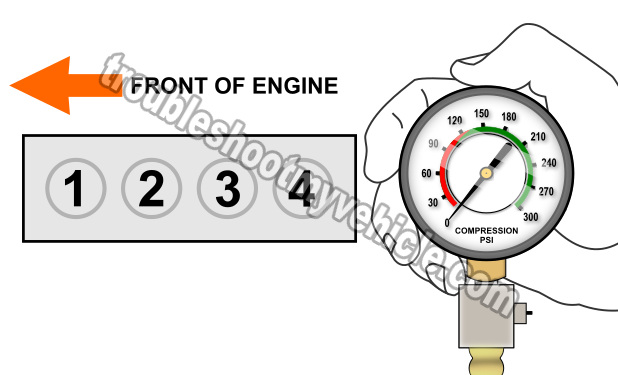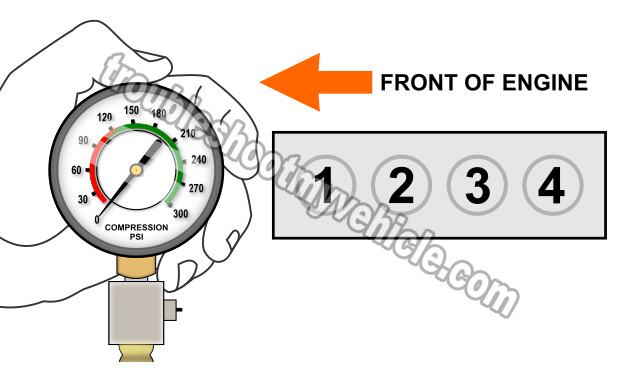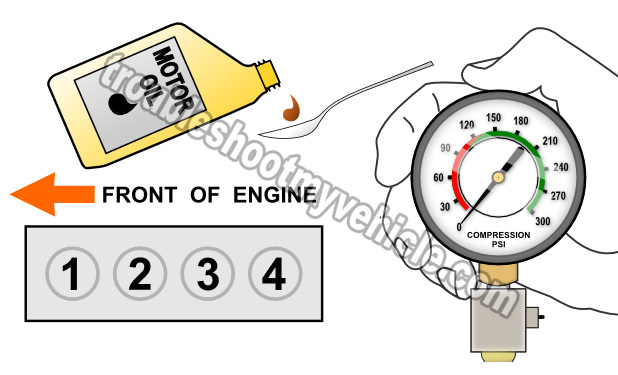
In this article, I'm gonna' show you how to do an engine compression test on your Nissan 2.4L Altima, Pathfinder or Xterra vehicle.
An engine compression test is not hard to do (since you're only dealing with 4 cylinders) and it should take you about 30 minutes to do.
Contents of this tutorial:
Important Tips And Suggestions
TIP 1: The compression test is done with the engine cranking, so you'll need to be careful and take all necessary safety precautions.
TIP 2: You'll need a helper to crank the engine for you, while you eye-ball the compression tester. My suggestion to your helper wait outside the vehicle till you're done setting up the test. Once the test is done, ask you helper to wait outside again. This will help you to avoid having him or her accidentally crank the engine while you're setting up the test.
TIP 3: If the engine starts, you should perform the compression test with the engine warmed up, but not completely hot (normal operating temperature). If the engine does not start, don't worry about it.
Symptoms Of Low Or No Engine Compression
Having low or no engine compression in one cylinder on your 2.4L Altima (Frontier, or Xterra) will cause your engine to miss at idle and you'll definitely feel there's something wrong when you accelerate the vehicle.
When this happens (low or no compression on just one cylinder), you'll see one of the following misfire diagnostic trouble codes:
- P0300: Random Cylinder Misfire.
- P0301: Cylinder #1 Misfire.
- P0302: Cylinder #2 Misfire.
- P0303: Cylinder #3 Misfire.
- P0304: Cylinder #4 Misfire.
Now, a lot of times, low compression at idle, will only cause a Rough Idle Condition and it won't set a Misfire Trouble Code at all.
The next common scenario is having low or no engine compression on two engine cylinders and your Altima (Frontier, or Xterra) won't start. It'll crank but not start. This usually indicates a blown head gasket.
If a blown head gasket is a concern, take a look at this tutorial I've written: How To Troubleshoot A Blown Head Gasket (Nissan 2.4L, 2.5L).
When you have a situation where you have NO compression on ALL 4 cylinders, you'll see:
- When you crank the engine over, it cranks very fast and this fast cranking speed is very noticeable.
- You'll have spark (in every cylinder), so you know it's not an ignition system issue.
- The fuel injectors spray fuel.
- You can confirm this with a Noid light test.
- Also, you can confirm this, although indirectly, by removing the spark plugs and checking to see if they are fuel soaked (fuel fouled).
- The most common causes of this scenario, are:
- Blown head gasket.
- Broken timing chain.
- Engine thru' a rod.
OK, having covered the most common scenarios of low compression and no compression, let's get testing to see if this is the case on your 2.4L Altima (Frontier, or Xterra).
Which Compression Tester Should I Buy?
There are lot of engine compression testers to choose from and many places to buy them. I'm gonna' make some recommendations to you:
Disclosure: As an Amazon Associate, I earn from qualifying purchases. If my tutorials help you, using these links is an easy way to support the site at no extra cost to you. Thank you!
TEST 1: 'Dry' Engine Compression Test

Let's jump right into the 'dry' Engine Compression Test.
Before you start, let me just say (one more time) that you'll be working around a cranking engine, so you have to be careful and stay alert at all times.
This is a pretty easy test and at the end, I'll show you how to interpret your test results. If you do find that you do have one or several engine cylinders with low compression, I recommend testing those cylinders with a 'wet' compression test (and you'll find the instructions for this 'wet' compression test in page 3 of this article).
Alright, let's start:
- 1
Disable the fuel system. This will prevent fuel from being injected into the cylinders as you perform the test.
You can do this by disconnecting all of the fuel injectors or by removing the fuel pump relay. - 2
Disable the ignition system. This will prevent the ignition coil pack from creating and delivering spark to the spark plug wires.
You can accomplish this by disconnecting the distributor from its electrical connector(s). - 3
Now, disconnect the spark plug wires (label them before you disconnect them) and the remove all 6 spark plugs.
As you're taking them out, be careful and don't drop any of them on the floor, or you could cause the spark plug's ceramic insulator to break, and this will cause a misfire! - 4
Thread the engine compression gauge into the spark plug hole for the number 1 engine cylinder (this is the spark plug hole closest to the drive belt).
Hand tighten the compression gauge only! Do not use any type of tool to get it tight. - 5
Have your helper crank the engine.
- 6
When the tester's needle stops climbing, have your helper stop cranking the engine.
- 7
Now, at whatever number the needle, on the gauge, stops, write this number down along with the number of the cylinder.
This number will be the maximum compression value for that specific cylinder. - 8
Repeat steps 4-7 on the other cylinders.
Let's take a look at how to interpret your test results:
CASE 1: No compression in 2 or more cylinders. This test result tells you that the engine has serious internal problems.
The most common issues behind this test result would be:
- Broken timing chain.
- A blown head gasket.
- The engine threw a rod.
CASE 2: Low compression in one or more cylinders. To a certain point, it's normal for the compression to vary a little between cylinders (as the engine accumulates thousands of miles). But if these values vary too much, then you're gonna' have a bonafide misfire on your hands.
So, your next step is to do the math and find out if these compression values are within normal parameter or not. Go to: Interpreting Your Compression Test Results.
Interpreting Your Compression Test Results
If the compression values you obtained from TEST 1 vary between each other, the next step is to find out if they're causing an engine performance problem.
Generally, a compression value that varies by more than 15% of the highest value you obtained will cause a problem.
This problem will manifest itself as a misfire and cause a rough idle condition.
You can easily and quickly find out if any low compression value is causing a problem by doing some math.
You can do this one of two ways: You can calculate this 15% difference with pen and paper or you can use my low compression calculator. You can find the low compression calculator here: Online Low Engine Compression Calculator (at: easyautodiagnostics.com).
If you want to manually calculate the 15% difference, here's what you'll need to do:
- STEP 1: Multiply the highest compression value by 0.15 (this is the decimal value of 15%).
- STEP 2: Round the result to the nearest one (for example: 25.6 would become 26).
- STEP 3: Subtract the result (the number that was rounded) from the highest compression value.
- ANSWER: The result of this subtraction is the lowest possible compression value any cylinder can have.
Now, let me give you a more specific example: Let's say that my engine compression test produced the following compression readings:
| Cylinder | Pressure |
|---|---|
| #1 | 165 PSI |
| #2 | 95 PSI |
| #3 | 155 PSI |
| #4 | 175 PSI |
My next step is to do the following calculation:
- STEP 1: 175 x 0.15 = 26.25.
- STEP 2: 26.25 = 26 (rounded to nearest one).
- STEP 3: 175 - 26 = 149.
- ANSWER: 149 PSI. Any cylinder with this compression (or lower) value will misfire.
Since cylinder #2 is only producing 95 PSI, I can now conclude that it's 'dead' and causing a misfire.
To find out if the lowest compression value you got from your engine compression test is within a good range, you'll need to do the same calculation. Of course, you'll need to use the highest compression value you got and not the one in the example.
Once you've found the 'dead' cylinder, the next step is to find out what's causing the low compression value. For this step, go to: TEST 2: 'Wet' Engine Compression Test.
TEST 2: 'Wet' Engine Compression Test

After interpreting the results of your 'dry' compression test, and you have one or several cylinders with low compression, the next step is to do what's called a 'wet' compression test.
This involves adding a few drops (2 tablespoons) of engine oil to the cylinders with the low engine compression result.
Now, you may be asking yourself, why a wet compression test? Well, because it'll help you to determine if the low cylinder pressure or pressures you recorded in the 'dry' compression test are caused by worn piston rings or worn cylinder head valves.
Depending on whether the compression pressure rises (on your compression tester) or not, you'll be able to say that the problem lies in the piston's rings or in the cylinder head valves.
OK, this is what you need to do:
- 1
Add a small amount of engine oil to the cylinder that reported low compression or no compression in the 'dry' compression test.
The amount should be about 1 to 2 tablespoons of oil. - 2
Install the compression tester onto the cylinder.
Do not use any type of tool to tightened the compression tester. Hand tight is fine. - 3
When all is set up, have your helper crank the engine.
- 4
You'll get one of two results:
1.) The compression value will go up (from the one you recorded before).
2.) The compression value will stay the same.
CASE 1: The compression value shot up. This tells you that the piston compression rings are worn out and thus the problem is in the bottom end (block) of the engine in your 2.4L Nissan Altima (Frontier or Xterra).
CASE 2: The compression value stayed the same. This test result tells you that the low compression in this specific cylinder is due to bad cylinder head valves.
Related Test Articles
You can find all of the Nissan 2.4L specific test articles here: 2.4L Nissan Index Of Articles.
Here's a sample of the tutorials you'll find in the index:
- How To Test The Fuel Injectors (Nissan 2.4L).
- How To Test The Starter Motor (Nissan 2.4L -Frontier, Xterra).
- How To Troubleshoot A Blown Head Gasket (Nissan 2.4L, 2.5L).

If this info saved the day, buy me a beer!




